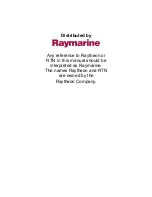
PRIMUS
r
880 Digital Weather Radar System
A28- 1146- 102- 00
Federal Aviation Administration (FAA) Advisory Circulars
A- 9
Airborne weather avoidance radar is, as its name implies, for avoiding
severe weather - not for penetrating it. Whether to fly into an area of
radar echoes depends on echo intensity, spacing between the echoes,
and the capabilities of you and your aircraft. Remember that weather
radar detects only precipitation drops; it does not detect turbulence.
Therefore, the radar scope provides no assurance of avoidance
turbulence. The radar scope also does not provide assurance of
avoiding instrument weather from clouds and fog. Your scope may be
clear between intense echoes; this clear does not mean you can fly.
Remember that while hail always gives a radar echo, it may fall several
miles from the nearest cloud and hazardous turbulence may extend to
as much as 20 miles from the echo edge. Avoid intense or extreme level
echoes by at least 20 miles; that is, such echoes should be separated
by at least 40 miles before you fly between them. With weaker echoes
you can reduce the distance by which you avoid them.
DO’S AND DON’TS OF THUNDERSTORM FLYING
Above all, remember this: Never regard any thunderstorm lightly even
when radar observers report the echoes are of light intensity. Avoiding
thunderstorms is the best policy. Following are some do’s and don’ts
of thunderstorm avoidance:
D
Don’t land or take off in the face of an approaching thunderstorm. A
sudden gust front of low level turbulence could cause loss of control.
D
Don’t attempt to fly under a thunderstorm even if you can see
through to the other side. Turbulence and wind shear under the
storm could be disastrous.
D
Don’t fly without airborne radar into a cloud mass containing
scattered embedded thunderstorms. Scattered thunderstorms not
embedded, usually can be visually circumnavigated.
D
Don’t trust the visual appearance to be a reliable indicator of the
turbulence inside a thunderstorm.
D
Do avoid, by at least 20 miles, any thunderstorm identified as severe
or giving an intense radar echo. This is especially true under the
anvil of a large cumulonimbus.
D
Do circumnavigate the entire area if the area has 6/1 thunderstorm
coverage.
D
Do remember that vivid and frequent lightning indicates the
probability of a severe thunderstorm.
D
Do regard as extremely hazardous, any thunderstorm with tops
35,000 feet or higher, whether the top is visually sighted or
determined by radar.
Summary of Contents for Primus 880
Page 1: ......
















































